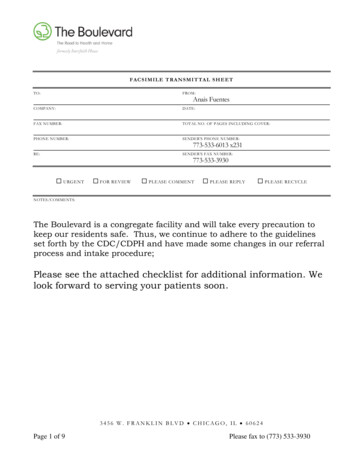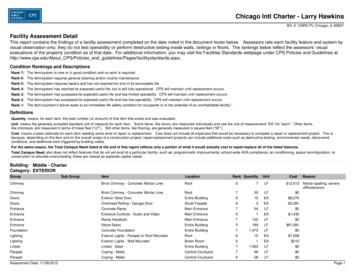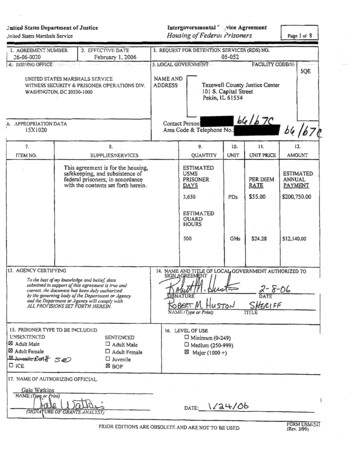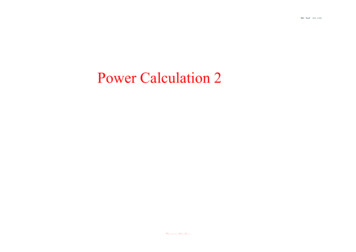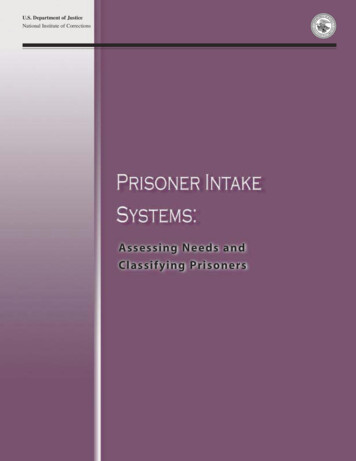
Transcription
DEPAALAssessing Needs andClassifying PrisonersINECONTIONSN ATINational Institute of CorrectionsNT OF JMEURTICESTU.S. Department of JusticeS TITUTE OF CORR
U.S. Department of JusticeNational Institute of Corrections320 First Street N.W.Washington, DC 20534Morris L. Thigpen, DirectorLarry Solomon, Deputy DirectorSusan M. Hunter, Chief, Prisons DivisionMadeline Ortiz, Project ManagerNational Institute of CorrectionsWorld Wide Web Sitehttp://www.nicic.org
Prisoner Intake Systems:Assessing Needs andClassifying PrisonersPatricia L. Hardyman, Ph.D.James Austin, Ph.D.Johnette Peyton, M.S.The Institute on Crime, Justice, and Corrections atThe George Washington UniversityFebruary 2004
This report was funded by the National Institute of Corrections (NIC) under cooperative agreement#01P13GIN8 with The George Washington University. Points of view or opinions stated in this documentare those of the authors and do not necessarily represent the official position or policies of the U.S.Department of Justice or the Washington, North Carolina, Colorado, or Pennsylvania departments ofcorrections.
AcknowledgmentsThe Institute on Crime, Justice, and Corrections would like to acknowledge thelong-term support of Sammie Brown, formerly with the National Institute ofCorrections and now back home in South Carolina. She has been a strong and persistent advocate of objective prison classification and NIC’s technical assistanceprogram. We would also like to thank the following for their invaluable participation in this project: James Thatcher, Chief of Classification, Washington StateDepartment of Corrections; Steve Hromas, Director of Research, ColoradoDepartment of Corrections; William A. Harrison, Director of Inmate Services,Pennsylvania Department of Corrections; and Lee West, Diagnostic ServicesBranch Program Manager, North Carolina Department of Correction. Finally, wewould like to thank Andrew Peterman, Aspen Systems Corporation, for editing andcoordinating the production of this report.iii
ContentsAcknowledgments . . . . . . . . . . . . . . . . . . . . . . . . . . . . . . . . . . . . . . . . . . . . . . .iiiExecutive Summary . . . . . . . . . . . . . . . . . . . . . . . . . . . . . . . . . . . . . . . . . . . . .viiNational Overview . . . . . . . . . . . . . . . . . . . . . . . . . . . . . . . . . . . . . . . . . .viiImprovements to the Assessment Process . . . . . . . . . . . . . . . . . . . . . . . .ixFindings From Case Studies of Four States . . . . . . . . . . . . . . . . . . . . . . .ixConclusions . . . . . . . . . . . . . . . . . . . . . . . . . . . . . . . . . . . . . . . . . . . . . . .xiiiChapter 1: Introduction . . . . . . . . . . . . . . . . . . . . . . . . . . . . . . . . . . . . . . . . . . .1Background . . . . . . . . . . . . . . . . . . . . . . . . . . . . . . . . . . . . . . . . . . . . . . . .1About This Report . . . . . . . . . . . . . . . . . . . . . . . . . . . . . . . . . . . . . . . . . . .1Chapter 2: National Overview . . . . . . . . . . . . . . . . . . . . . . . . . . . . . . . . . . . . . .5Facility Characteristics . . . . . . . . . . . . . . . . . . . . . . . . . . . . . . . . . . . . . . . .5Facility Functions . . . . . . . . . . . . . . . . . . . . . . . . . . . . . . . . . . . . . . . . . . . .8Intake Components and Personnel Responsibilities . . . . . . . . . . . . . . . . .9Obstacles to Intake Assessments . . . . . . . . . . . . . . . . . . . . . . . . . . . . . . .13Chapter 3: Colorado Department of Corrections . . . . . . . . . . . . . . . . . . . . .15Corrections Population . . . . . . . . . . . . . . . . . . . . . . . . . . . . . . . . . . . . . . .15Intake Facilities . . . . . . . . . . . . . . . . . . . . . . . . . . . . . . . . . . . . . . . . . . . .15The Intake Process . . . . . . . . . . . . . . . . . . . . . . . . . . . . . . . . . . . . . . . . . .16Processing Time and Flexibility . . . . . . . . . . . . . . . . . . . . . . . . . . . . . . .19Classification . . . . . . . . . . . . . . . . . . . . . . . . . . . . . . . . . . . . . . . . . . . . . .19Needs Assessment . . . . . . . . . . . . . . . . . . . . . . . . . . . . . . . . . . . . . . . . . .20Chapter 4: Washington State Department of Corrections . . . . . . . . . . . . . .23Corrections Population . . . . . . . . . . . . . . . . . . . . . . . . . . . . . . . . . . . . . . .23Intake Facilities . . . . . . . . . . . . . . . . . . . . . . . . . . . . . . . . . . . . . . . . . . . .23The Intake Process . . . . . . . . . . . . . . . . . . . . . . . . . . . . . . . . . . . . . . . . . .24Processing Time and Flexibility . . . . . . . . . . . . . . . . . . . . . . . . . . . . . . .27v
Classification . . . . . . . . . . . . . . . . . . . . . . . . . . . . . . . . . . . . . . . . . . . . . .28Needs Assessment . . . . . . . . . . . . . . . . . . . . . . . . . . . . . . . . . . . . . . . . . .29Chapter 5: Pennsylvania Department of Corrections . . . . . . . . . . . . . . . . . .33Corrections Population . . . . . . . . . . . . . . . . . . . . . . . . . . . . . . . . . . . . . . .33Intake Facilities . . . . . . . . . . . . . . . . . . . . . . . . . . . . . . . . . . . . . . . . . . . .33The Intake Process . . . . . . . . . . . . . . . . . . . . . . . . . . . . . . . . . . . . . . . . . .34Processing Time and Flexibility . . . . . . . . . . . . . . . . . . . . . . . . . . . . . . .36Classification . . . . . . . . . . . . . . . . . . . . . . . . . . . . . . . . . . . . . . . . . . . . . .37Needs Assessment . . . . . . . . . . . . . . . . . . . . . . . . . . . . . . . . . . . . . . . . . .39Chapter 6: North Carolina Department of Correction . . . . . . . . . . . . . . . . .43Corrections Population . . . . . . . . . . . . . . . . . . . . . . . . . . . . . . . . . . . . . . .43Intake Facilities . . . . . . . . . . . . . . . . . . . . . . . . . . . . . . . . . . . . . . . . . . . .44The Intake Process . . . . . . . . . . . . . . . . . . . . . . . . . . . . . . . . . . . . . . . . . .44Processing Time and Flexibility . . . . . . . . . . . . . . . . . . . . . . . . . . . . . . .49Classification . . . . . . . . . . . . . . . . . . . . . . . . . . . . . . . . . . . . . . . . . . . . . .49Needs Assessment . . . . . . . . . . . . . . . . . . . . . . . . . . . . . . . . . . . . . . . . . .51Chapter 7: Implications of the Research . . . . . . . . . . . . . . . . . . . . . . . . . . . .55Notes . . . . . . . . . . . . . . . . . . . . . . . . . . . . . . . . . . . . . . . . . . . . . . . . . . . . . . . . .57Appendix A: Colorado Department of Corrections Admission DataSummary and Diagnostic Narrative Summary . . . . . . . . . . . . . . . . . . . . . . .61Appendix B: Washington Department of Corrections RiskManagement Identification Worksheet . . . . . . . . . . . . . . . . . . . . . . . . . . . . . .69Appendix C: Pennsylvania Department of CorrectionsClassification Summary . . . . . . . . . . . . . . . . . . . . . . . . . . . . . . . . . . . . . . . . . .77vi
Executive SummaryDespite increased prison admissions and populations, state prison systems havedeveloped detailed prisoner intake systems to assess the risks and needs of inmates.Working under the assumption that specific tasks, sequences, assessments, and system sophistication would vary according to the agency’s goal, size, and needs, thisresearch project sought to determine the tasks, assessments, and technology used inthe intake process.The study was implemented in two phases. First, a national review of the 50 statecorrectional agencies was administered. This review captured data about populations, facility functions, intake components, personnel responsibilities, andstrengths and weaknesses of the assessment process. Second, four states wereselected from the national review and examined more closely.National OverviewIntake Populations Since most prisoners are males, most intake facilities process only male prisoners. Few states have facilities that process both males and females. Monthly admission rates of males and females varied among the 50 states. Inall, an estimated 45,000 males and 5,500 females were admitted each month tostate correctional facilities. This translates into approximately 600,000 admissions per year. A prisoner’s length of stay at an intake facility varied as well. Nationally, theaverage length of stay was 40 days for males and 31 days for females.Facility FunctionsAll state intake facilities provide a core set of prisoner intake functions thatinclude— Identifying the prisoner. Developing the prisoner’s record. Conducting medical and mental health assessments. Determining the prisoner’s threat to public safety and his/her securityrequirements. Identifying security threat group members. Identifying sex offenders, sexual predators, and vulnerable inmates.vii
Executive SummaryIn approximately two-thirds of the states, personnel at the intake facilities recommend housing and cell assignments. The remaining states defer such tasks to thefacility to which the prisoner is transferred.Most prisoner intake systems include comprehensive medical, mental health, andsecurity assessments. These systems help ensure that prisoners are properly classified, housed, and provided with critical medical and mental health services andprogramming.Most states employ a central classification office to set classification and needsassessment policies and review custody recommendations. The office also mayaudit and perform quality control functions of the prisoner classification system atboth the intake and long-term facilities. It less frequently determines housingassignments or sets the sequence of intake tasks. Other duties of the central office,as indicated by the review, include— Arranging transportation to the long-term facility. Scheduling transfers to the long-term facility. Identifying and validating security threat group membership.Intake ComponentsIdentification. Personal identification is the only component of the intake processthat is mandatory nationwide. Trained security staff verify the prisoner’s identityduring his/her first day at the facility. Fingerprints, photographs, and inventories ofthe prisoner’s personal items are common to most identification procedures. Moststates also identify a prisoner’s affiliation with security threat groups. This type ofinformation is critical in determining whether a prisoner needs to be separated fromother inmates or staff members.In scope, analyzing a prisoner’s medical, mental, and educational needs consumesa significant portion of the identification assessment component. Medical screens,physical examinations, criminal history checks, and substance abuse tests are conducted in every state. Mental health screens and academic achievement tests areconducted in 98 percent of states. Psychological testing and prisoner separation concerns are addressed in 96 percent of states. Together with other assessments performed less frequently, these tests help determine the level of programming,educational, and treatment services needed. Test results also provide critical data forprisoner classification and housing and work assignments.Classification. The results of the medical, mental health, and educational tests aremade available to classification staff, who compile a social and criminal history ofthe prisoner, identify potential separation needs from staff and/or other inmates, andreview the presentence investigation report (if available) to determine the initial custody level, housing requirements, and program needs.viii
Most (86 percent) state correctional agencies use the same classification assessmentcriteria for both males and females. However, a few states—including Idaho,Massachusetts, New York, and Ohio—have developed gender-specific classificationinstruments.Needs assessment. Needs assessments determine the programs and/or services inwhich the prisoner should be encouraged to participate while incarcerated. Moststates conduct mandatory medical, mental health, education, alcohol abuse, anddrug abuse assessments through interviews and standardized testing instruments.More indepth needs assessments address anger management, work and vocationaltraining, English as a second language, criminogenic risks and needs, and prerelease/reentry planning needs. Less than 20 percent of states assess life skills, sexoffender, compulsive behavior, financial management, parenting, and aging/elderlyneeds.Improvements to the Assessment ProcessThe national review identified several factors that, when implemented, will allowprison systems to conduct more timely, accurate, and useful assessments: Enhanced and timely data sharing among intake facilities, courts, and other correctional agencies. Linked management information systems. Validated risk and needs assessment tools. Increased bed and administrative office space at intake facilities.Findings From Case Studies of Four StatesColorado, Washington, Pennsylvania, and North Carolina were visited to betterunderstand the structure and content of their prison intake systems. The systems aresimilar in scope and outline but differ in duration, day-to-day operations, classification procedures, and needs assessment tools.Certain characteristics are common to all four state systems: All have separate intake facilities for males and females. All conduct orientations that, at a minimum, acquaint prisoners with the facility’s rules. North Carolina appears to conduct the most detailed orientation,which includes videos about the facility, prisoner responsibilities, and diseases as well as questionnaires about drug use, potential visitors, and familybackground.ix
Executive Summary All assess prisoners for security threat group participation as part of the identification component of the intake process. All perform medical, mental health, educational, and substance abuse testing onall prisoners. Medical tests include physical exams, blood tests, and dentaland/or vision tests. Educational tests include academic achievement and intelligence tests. DNA testing is limited to prisoners committed for violent crimes(murder and stalking in Pennsylvania) and sex offenses. More indepth screening—including criminogenic, vocational training, sex offender, special education, life skills, and elderly needs—may be required for certain classes ofprisoners or are conducted as appropriate. Test results in all four states arescored and forwarded electronically to classification staff. All classification processes include inmate interviews and case file reviews(including criminal and social histories and separation needs). Classificationstaff prepare a written recommendation to the central office regarding facilityassignment and custody level, which the central office reviews and eitherapproves or changes. All scoring systems are based on similar factors to determine custody levels,although the scoring and degree of automation varies from state to state.Scoring factors used in all four states include the severity of current convictions,history of institutional violence, escape history, and one or more stability factors (e.g., age, education, marital status, employment). Other factors used in oneor more states include institutional adjustment, disciplinary infractions, currentor pending detainers, number and severity of prior convictions, history of community violence, history of substance abuse, and time to expected release. All classification systems allow for both mandatory and discretionary overrides.Custody overrides are most common for female prisoners.Each state intake system also has characteristics that set it apart from the others.These characteristics are discussed briefly below and in more detail in the report.Colorado The Colorado Department of Corrections processes its prisoners through twointake facilities—one for males and one for females—over the course of 14days. During days 1–3, prisoners are identified and undergo medical, mental, educational, and substance abuse tests. All prisoners also receive a tuberculosis test. During days 4–7, a counselor prepares a written case summary and classification recommendation, which the central office approves or modifies. By day 14,prisoners are transferred to long-term facilities.x
To determine prisoners’ needs, Colorado assesses 13 problem areas using ascale of 1 (low or no needs) to 5 (high needs). Of these 13 areas, 2 (compulsivebehavior and sex offender needs) are examined only as needed. Informationfrom the case file and/or a brief interview with the offender are automaticallycoded to generate a score for the 10 subscales of the Level of Services Index—Revised (LSI–R). Automating the LSI–R has allowed Colorado to integrate itinto the intake process without dramatically increasing staff workload or a prisoner’s length of stay at the intake center.Washington The Washington Department of Corrections processes its prisoners through twointake facilities—one for males and one for females—during a 24-day process. During days 1–11, prisoners are identified and tested. During orientation (days2 and 5), prisoners become acquainted with facility rules and are assigned tocounselors living in their units. During days 12–16, classification staff recommend a preliminary custody level. During days 21–24, central office staff review and approve (and may change)the recommended custody level and determine facility assignment. InWashington, the long-term facility assigns housing. Bedspace at the long-termfacility dictates when prisoners are transferred from the intake facility, typically between days 25 and 80. The LSI–R serves as Washington’s primary needs assessment tool. The LSI–Ris generally completed by community corrections personnel before the prisoners arrive at the intake facility. If not, it must be completed within 6 months oftheir transfer to the long-term facility. The LSI–R is integral to Washington’sRisk Management Information system, which identifies high-risk prisonersaccording to their “risk of reoffending” and “nature of harm done.” The systemcombines scores from the LSI–R and a harm-done scale to create a risk management rating that determines a prisoner’s programming and treatment needs.Pennsylvania The Pennsylvania Department of Corrections processes its prisoners throughfour intake facilities—three for males and one for females—during a 4- to 6week intake process. By the 10th day at the intake center, all prisoners have been identified andassessed. Counselors conduct an orientation session, usually on day 2, toexplain institutional rules and procedures. Pennsylvania’s classification procedures occur from days 11 to 15. In additionto interviews and case reviews, Pennsylvania uses PACT (PennsylvaniaAssessment and Classification Tool)—an objective, behavior-driven automatedclassification system—to synthesize data collected throughout the intakexi
Executive Summaryprocess. PACT helps classification staff establish custody levels and recommend housing, work detail, treatment, and program assignments. PACT sortsprisoners into one of five custody levels: community corrections, minimum,medium, close, and maximum. Of Pennsylvania’s 14 needs assessments, 7 must be completed for all prisoners:medical/dental, mental health, education, alcohol abuse, drug abuse, workskills, and parenting. Before transfer, the prisoner’s identification, classification, and needs assessment information are captured in a classification summary. This summaryserves as the basis for the correctional plan, which is developed by staff at thelong-term facility. The plan identifies programs to address the prisoners’ needsand is reviewed and updated at least annually.North Carolina Of the four state correctional departments, North Carolina processes prisonersmost quickly (10 days) and operates the most intake facilities (eight). Theresearch concentrated on three facilities: one for males, one for adult and youngfemales, and one for 19- to 21-year-old males. Unlike the other three states, North Carolina conducts identification tasks at thecounty jail—before the prisoner arrives at the intake facility—and again at theintake center. North Carolina conducts orientation and all medical, mental, andsubstance abuse tests in 4 days. Medical and dental examinations are splitbetween days 2 and 4; academic, intelligence, and substance abuse tests are performed on day 3. During days 5–7, case analysts create a report of the custody, program, andfacility recommendations. The intake facility’s classification committee reviewsthe recommendations, which the facility director must approve. The recommendations are forwarded to the central office for review and approval.Typically, on day 10, the prisoner is transferred to a permanent facility. North Carolina’s automated classification system is an objective risk-based system designed to address the prisoner’s institutional conduct, safety, and adjustment. Custody levels of adult and young prisoners are scored using the sameeight risk factors, but on different scales. Mandatory assessments are performed for 6 of 16 possible needs areas: medical/dental, mental health, education, alcohol abuse, drug abuse, and workneeds. Parenting skills are assessed for female prisoners based on their criminaland social histories or on request. North Carolina law mandates testing of allyoung prisoners for special education needs.xii
As in Pennsylvania, a custody referral narrative is created that contains identification, classification, and needs assessment data. The case manager at thelong-term facility uses this referral to develop a case management plan thatspecifies program assignments and their sequence. As warranted, the plan isupdated to reflect disciplinary actions and program completion. Each task in North Carolina’s intake system includes automated forms andscreens for staff to record data.ConclusionsThe diverse facilities, populations, factors, and models presented by the states suggest that there is still much to learn about prison intake systems. The data suggestthat better integration of the institutional and community risk, needs assessment,and case management processes and planning is needed to— Maximize resources. Ensure the safety and security of correctional systems and communities. Better prepare prisoners for their release. Support the communities to which prisoners are released.Through the results of this study, future technical assistance efforts will enablestates to develop intake systems that are practical given the realities of larger inmatepopulations and fewer resources. Future initiatives should concentrate on modelsthat require reasonable efforts in terms of staff training, tool validation, and processimplementation.xiii
oneChapterIntroductionBackgroundDuring the past several decades, the population of the nation’s prison system hasincreased dramatically. Approximately 200,000 persons were housed in the nation’sprisons in 1970. By 2002, that number had increased to approximately 1.4 million.It is now estimated that more than 600,000 admissions and releases occur each year.Not only are prison systems facing growing populations, but they are doing so withdeclining resources. Controlling and servicing the rising population with fewerresources becomes more critical with each new admission.As a result, there is a need to develop prisoner intake systems (both procedures andassessment tools) that will facilitate and expedite appropriate custody, housing, andprogramming decisions. It is equally vital to ensure that such decisions are based onthe most reliable and valid assessment tools available to the field.Controlling and servicing the rising population with fewerresources becomesmore critical witheach new admission.For each admission, a systematic and highly structured intake process is required todetermine (among other things) the prisoner’s custody level, his/her medical andmental health needs, and appropriate assignment to in-prison programs and/or services. Traditional intake processes have focused narrowly on classification; that is,determining the prisoner’s custody level (e.g., minimum, medium, close, etc.) andthe facility to which the prisoner should be transferred once classified. Very littleattention has been devoted to how a prisoner should be housed and programmedonce he/she arrives at the long-term facility. Clearly, accurate internal and externalclassification decisions are critical for a well-managed, safe prison system.1About This ReportThis report explores the variety of approaches to the intake process used by statecorrectional agencies throughout the United States. It identifies purposes, specifictasks, sequences of events/tasks, staffing levels, and levels of automation. Bothapproaches and the terminology (e.g., assessment and orientation, reception, intake,admission, diagnostics, etc.) vary from state to state. To simplify such language forthis document, the term “intake system” refers to the entire admission and assessment process, including identification of the prisoner, compilation of his/her criminal and social histories, assessment of the prisoner’s needs (e.g., medical, mentalhealth, education, etc.), and classification (both internal and external).1
Chapter 1This project sought to determine the tasks and assessments included in the intakeprocess and the “state of the art” among state correctional agencies. The researchassumed that no one model or process was ideal but rather that specific tasks,sequences, assessments, and system sophistication would vary according to thegoal, size, and needs of the correctional agency.The study was implemented in two phases. First, a national review of the prisonadmission processes and initial classification procedures and assessment tools wasconducted to learn what state correctional agencies were doing to identify andassess newly admitted prisoners. Each correctional agency was asked about itsprocesses related to initial intake, classification, needs assessment and any periodicreassessment, and program assignment. The results of this review are summarizedin chapter 2.Based on this national review and in consultation with NIC, prison intake systemsof four states (Colorado, Washington, Pennsylvania, and North Carolina) wereselected for a more extensive review. Each state was visited to better understand thestructure and content of its prison intake system. A detailed itinerary was preparedto ensure that the information gathered across the sites was consistent and that anyspecial features of an agency’s process were highlighted. The Colorado Department of Corrections (CO DOC) was chosen for its sophisticated management information system that includes an intake module for collecting and compiling prisoners’ criminal histories. Colorado uses the Level ofServices Index-Revised (LSI–R) assessment for each prisoner as part of theintake process. Because this instrument has been adopted by several correctional agencies across the country, an evaluation of its use during the prison intakeprocess was highly pertinent. The Washington State Department of Corrections (WA DOC) was chosen forreview because of its comprehensive incarceration plan, which identifies andaddresses each prisoner’s criminogenic needs and risks as part of its intakeprocess. Reducing recidivism among high-risk prisoners is a goal of many stateand federal agencies, and studying Washington’s efforts at early identificationof high-risk prisoners could provide ideas for other states interested in implementing such procedures. Also, the WA DOC uses LSI–R as an assessment tool,providing another opportunity to study it. The Pennsylvania Department of Corrections (PA DOC) was selected becauseof its large size and its management information system, which includes thePACT (Pennsylvania Assessment and Classification Tool) classification module. Furthermore, the PA DOC develops a unique correctional plan for eachprisoner that identifies problem areas and treatment needs to be addressed bythe prisoner during incarceration.2 The North Carolina Department of Correction (NC DOC) was selectedbecause it, like Colorado, uses an automated information system that includesa module for collecting and compiling prisoners’ criminal histories. North
IntroductionCarolina operates eight intake facilities, making it a good case study of theadvantages and disadvantages of operating multiple intake facilities. Finally,North Carolina was studied for its effectiveness in assessing the needs ofwomen and youthful prisoners.Case studies of each state’s intake system are presented in chapters 3–6.3
twoChapterNational OverviewDuring fall 2001, a review was conducted of the 50 state correctional agencies in aneffort to document the current state of the art in prisoner intake systems. A 12-pagedraft instrument was developed in consultation with NIC and then pretested atselected jurisdictions. Once the pretest was completed, the questionnaire was mailedto the director/commissioner and the director of classification of the 50 state correctional agencies.A drawback with national reviews is that unless there is considerable followup witha representative in each state, the responses often will be either incorrect or incomplete. To remedy this, states were notified that after receiving the questionnaire, theywould be interviewed by an Institute on Crime, Justice, and Corrections (ICJC) representative who would record their responses to each question and address any questions they had about the questionnaire.The interviews were conducted between September and November 2001. Althoughall 50 states participated in the survey, not every state was able to respond to eachquestion. Nonetheless, the data provide a glimpse of how most states approach theintake process.As a result of thelarge increase in thenation’s prisonerFacility Characteristicspopulation duringExhibit 1 provides an overview of the number an
Executive Summary Despite increased prison admissions and populations, state prison systems have developed detailed prisoner intake systems to assess the risks and needs of inmates. Working under the assumption that specific tasks, sequences, assessments, and sys-tem sophistication would vary according to the agency's goal, size, and needs, this

